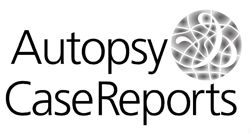Fetal akinesia deformation sequence with pontocerebellar hypoplasia, and migration and gyration defects
Meghan Elizabeth Kapp; Pamela Lyle; Hilary Highfield Nickols
Abstract
Keywords
References
1 Pena SD, Shokeir MH. Syndrome of camptodactyly, multiple ankyloses, facial anomalies, and pulmonary hypoplasia: a lethal condition. J Pediatr. 1974;85(3):373-5.
2 Ajayi RA, Keen CE, Knott PD. Ultrasound diagnosis of the Pena Shokeir phenotype at 14 weeks of pregnancy. Prenat Diagn. 1995;15(8):762-4.
3 Abe J, Nemoto K, Ohnishi Y, Kimura K, Honda T, Yoshizawa H. Pena-Shokeir I syndrome: a comparative pathological study. Am J Med Sci. 1989;297(2):123-7.
4 Chen H, Blackburn WR, Wertelecki W. Fetal akinesia and multiple perinatal fractures. Am J Med Genet. 1995;55(4):472-7.
5 Hoellen F, Schröer A, Kelling K, et al. Arthrogryposis multiplex congenita and Pena-Shokeir phenotype: challenge of prenatal diagnosis--report of 21 cases, antenatal findings and review. Fetal Diagn Ther. 2011;30(4):289-98.
6 Erdl R, Schmidtke K, Jakobeit M, Nerlich A, Schramm T. Pena-Shokeir phenotype with major CNS-malformations: clinicopathological report of two siblings. Clin Genet. 1989;36(2):127-35.
7 Hageman G, Willemse J, Ketel BA, Verdonck AF. The pathogenesis of fetal hypokinesia. A neurological study of 75 cases of congenital contractures with emphasis on cerebral lesions. Neuropediatrics. 1987;18(1):22-33.
8 Namavar Y, Barth PG, Poll-The BT, Baas F. Classification, diagnosis and potential mechanisms in pontocerebellar hypoplasia. Orphanet J Rare Dis. 2011;6(1):50.
9 Rudnik-Schöneborn S, Senderek J, Jen JC, et al. Pontocerebellar hypoplasia type 1: clinical spectrum and relevance of EXOSC3 mutations. Neurology. 2013;80(5):438-46.
10 Chen H, Blumberg B, Immken L, et al. The Pena-Shokeir syndrome: report of five cases and further delineation of the syndrome. Am J Med Genet. 1983;16(2):213-24.
11 Hall JG. Pena-Shokeir phenotype (fetal akinesia deformation sequence) revisited. Birth Defects Res A Clin Mol Teratol. 2009;85(8):677-94.
12 Michalk A, Stricker S, Becker J, et al. Acetylcholine receptor pathway mutations explain various fetal akinesia deformation sequence disorders. Am J Hum Genet. 2008;82(2):464-76.
13 Tan-Sindhunata MB, Mathijssen IB, Smit M, et al. Identification of a Dutch founder mutation in MUSK causing fetal akinesia deformation sequence. Eur J Hum Genet. 2015;23(9):1151-7.
14 Vogt J, Morgan NV, Marton T, et al. Germline mutation in DOK7 associated with fetal akinesia deformation sequence. J Med Genet. 2009;46(5):338-40.
15 Drachman DB, Weiner LP, Price DL, Chase J. Experimental arthrogryposis caused by viral myopathy. Arch Neurol. 1976;33(5):362-7.
16 Brueton LA, Huson SM, Cox PM, et al. Asymptomatic maternal myasthenia as a cause of the Pena-Shokeir phenotype. Am J Med Genet. 2000;92(1):1-6.
17 Farrell K, McGillivray BC. Arthrogryposis following maternal hypotension. Dev Med Child Neurol. 1983;25(5):648-50.
18 Rudzinski ER, Kapur RP, Hevner RF. Fetal akinesia deformation sequence with delayed skeletal muscle maturation and polymicrogyria: evidence for a hypoxic/ischemic pathogenesis. Pediatr Dev Pathol. 2010;13(3):92-201.
Submitted date:
05/20/2020
Accepted date:
07/09/2021
Publication date:
09/03/2021

